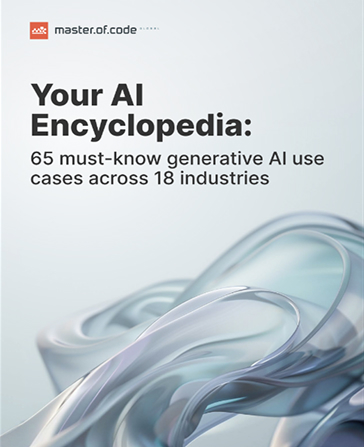In today’s competitive business arena, excelling in customer experience (CX) is what sets a company apart. As expectations from consumers soar, the role of artificial intelligence in delivering personalized and efficient services becomes pivotal. AI is not just an option; it’s a necessity for empathetic and responsive client care.
The impact of the technology on CX is backed by compelling statistics. Gartner forecasts a surge in AI investments, reaching over $10 billion in startups by 2026. The direction underscores the tool’s growing influence in the tech sector. Furthermore, 30% of new applications are expected to harness artificial intelligence by 2026 for adaptive, user-specific interfaces, offering seamless, tailored interactions.
Result-oriented enterprise leaders can’t afford to overlook these Conversational AI trends. The article is crafted to equip you with crucial insights into AI-driven CX advancements. We’ll discuss how to keep your customer service strategies dynamic and client-focused. Dive in to understand how AI can be the key to unlocking your business’s potential and staying ahead in the evolving marketplace.
Ready to bring Conversational AI into your customer care? Begin your journey towards smarter business interactions with our solutions.
GET IN TOUCH
Table of Contents
State of Artificial Intelligence in Customer Services
In today’s business environment, client experience faces significant challenges. Many companies struggle to deliver exceptional CX, impacting their brand reach and loyalty. Key issues include low customer satisfaction (CSAT), channel abandonment, and high churn rates. Additionally, these problems often result in inflated operational costs and revenue losses.
Fortunately, Conversational AI for customer service stands out as a solution to the pain points. In fact, businesses are already adopting this technology for strategic benefits in lead generation and user engagement. It offers a range of capabilities that enhance digital journey quality.
AI-powered systems ensure personalized interactions and proactive support, which helps lower buyer attrition and improves resolution times. Data-driven insights help to refine client care strategies and better understand market demands. Such improvements bolster consumer allegiance and retention, leading to increased sales and expansion opportunities.

To gain a deeper insight into this market, let’s delve into some key statistics about the CX landscape:
- CX struggles snapshot. 50% of decision-makers admit that their organization faces poor customer experience. Plus, ⅓ mentions difficulties in making their brand more known and influential in the market. Other issues include low CSAT or Net Promoter Score (NPS) rates (44%), abandoned channels (43%), and client churn (39%). These problems also lead to higher operational costs (54%) and revenue loss (51%).
- AI enhancement strategy. To address such challenges, 63% of executives plan to enhance or introduce consumer-facing artificial intelligence in the coming year. As a result, the adoption rate of conversational analytics, AI, and automation could increase from 17% to 76%.
- Investments focus. Currently, 52% of organizations have invested in these technologies. The innovations are employed to improve customer service capabilities (62%), elevate client satisfaction (36%), and reduce wait times (33%).
- Benefits from AI adoption. 97% of executives acknowledged that Conversational AI positively influenced user contentment. Additional advantages companies derived from it include enhanced agent productivity (94%), faster resolution of consumer issues (92%), and cost reduction (65%).
- Customers’ expectations. Clients eagerly anticipate increased AI interactions (73%), seeing its potential to enhance client care quality. Furthermore, 74% believe the technology will significantly boost service efficiency. Recognizing its ability to create personalized communication (74%), consumers expect it to match human-level assistance (75%).
Thus, as clients experience Conversational AI in customer service, excitement for the future grows. Business executives concur, with 41% warning that failing to adopt artificial intelligence risks lagging behind. In this context, identifying the trends reshaping brand-buyer interactions is crucial. For leaders aiming to stay ahead, grasping these directions is key to maintaining the company’s lead in CS innovation. So, let’s explore AI trajectories shaping tomorrow’s consumer engagement landscape.
7 Critical Conversational AI Trends: Guide Your Business to Lead, Not Follow
Conversational AI is swiftly reshaping the realm of customer interaction. By 2030, its market value is expected to soar to $32 billion, marking a 19% yearly growth since 2021. Such an expansion is fueled by the increased use of chatbots in businesses, with their adoption projected to nearly double in the next 2-5 years.
AI-powered bots are not just proliferating; they’re driving significant economic benefits. Predictions for 2025 suggest digital assistants could reduce client service costs by as much as $11 billion. This technology is especially pivotal in the financial and tech sectors, where enhancing CX is a top priority for 77% of professionals.
The impact of Conversational AI is particularly notable in contact centers. Gartner estimates that by 2026, its integration in these customer interaction hubs could cut agent labor costs by a staggering $80 billion. Furthermore, the post-pandemic era has seen artificial intelligence become essential, with a 250% increase in handled interactions, highlighting its crucial role in modern business.
While the numbers sound promising, let’s delve into the actual trends steering the future of Conversational AI. Our focus will be on how these directions define the CX domain, ushering in an age of advanced efficiency and user engagement.
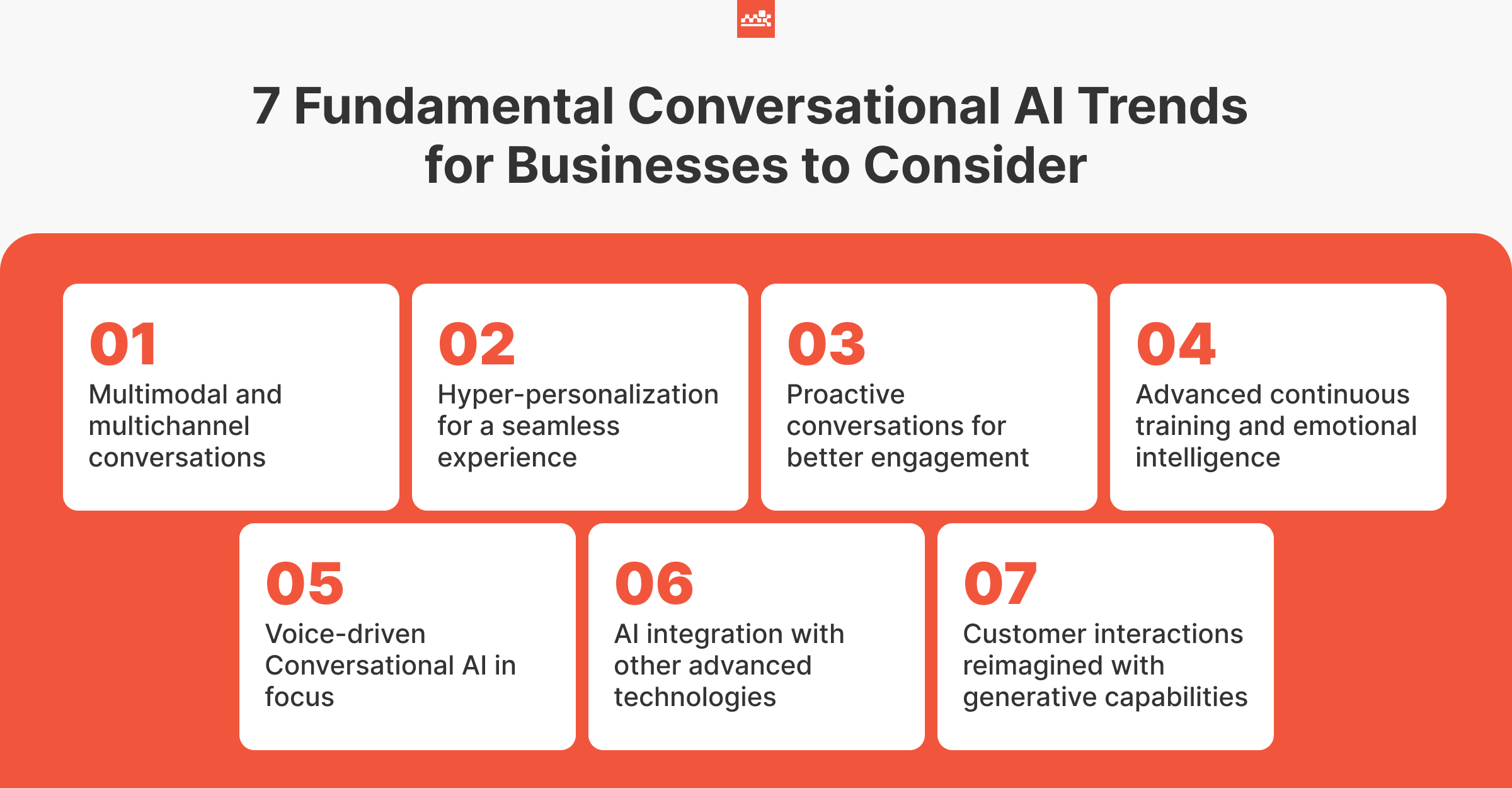
Proactive Conversations for Better Engagement
Conversational AI is now shifting from simply reacting to initiating proactive interactions. This leap is powered by intelligent analytics and advanced intent recognition. Utilizing real-time client data, these tools provide insights into preferences, sentiments, and behaviors. The observations empower marketers to refine conversational experiences more effectively.
In the realm of personalized customer conversations, proactive recommendations are becoming increasingly important. Approximately 65% of consumers favor receiving offers and suggestions that cater to their specific needs. Personal touch is a key factor in differentiating CX and enhancing user engagement strategies.
In conversational commerce, anticipatory consumer assistance is taking a front seat too. A significant 71% of customers show a preference for brands that deliver proactive support. Businesses are leveraging buyer data to anticipate and address their demands proactively. By analyzing behavior and patterns, chatbots are positioned to offer help or suggestions even before the customer requests it.
This approach to client care is boosting the CX to a completely new level. Not only does it save time, but it also conveys a sense of thoughtfulness and value to the consumers. In fact, 72% of users experiencing proactive support report higher satisfaction levels. Beyond reacting to inquiries, Conversational AI is now adept at interpreting information to forecast needs, thereby reducing buyer frustration and enhancing their loyalty.
Multimodal and Multichannel Conversations
Multimodal interfaces are revolutionizing how we interact, combining text, voice, images, and videos for richer dialogues. Such systems allow users to communicate more naturally, using voice commands, gestures, and emojis. This enhances experiences across various channels, making interactions more immersive.
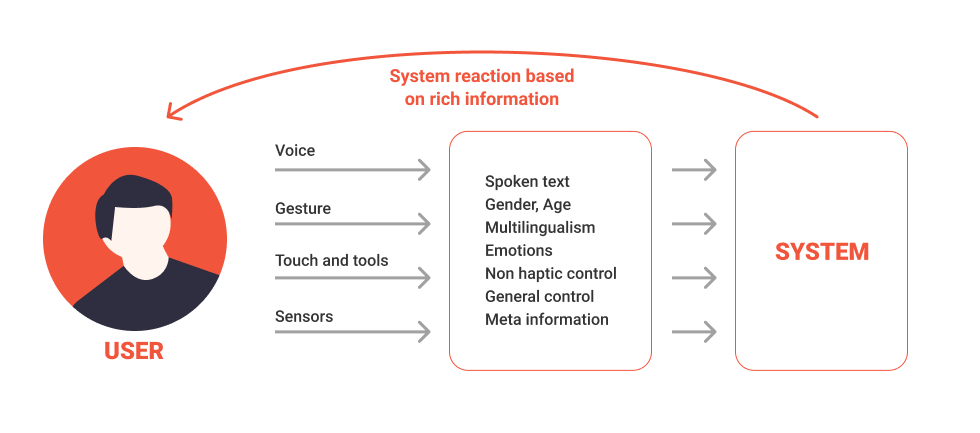
In fact, consumer preferences for brand touchpoints were diverse in 2022. Emails led with 64%, followed by website or app chats at 47%. Social media exchanges stood at 36%, and text messages at 28%. These trends indicate a clear shift towards mixed communication modes.
Nowadays, half of consumers prefer multimodal interactions as their go-to communication format. The choice is reshaping how brands approach customer engagement. IDC forecasts that by 2026, 30% of AI models will blend different data modalities. Such an integration will surpass the constraints of single-modality artificial intelligence, improving their effectiveness and self-learning capabilities.
The addition of AI components like image recognition and document processing is already streamlining work. For instance, tasks requiring extensive typing are now simplified through photo uploads. This not only saves time but also adds to the convenience. Looking forward, Conversational AI’s future seems to hinge on its ability to seamlessly incorporate multimodality across various channels.
Advanced Continuous Training and Emotional Intelligence
AI tomorrow is anchored in combining next-level model optimization with emotional competence. In fact, 7 out of 10 consumers now expect the technology to understand and react to their emotions. This anticipation is guiding the development of more empathetic chatbots. Today’s cutting-edge digital assistants use NLP and machine learning (ML) for effective self-improvement. And 72% of users have noticed AI’s growing ability to comprehend human language and communication styles.
In general, digital assistants are evolving by analyzing user input, identifying patterns, and deriving lessons from each interaction. The method enables them to respond more accurately and contextually. The results are further enhanced with the assistance of augmented intelligence, merging technology with human feedback. It allows experts to work alongside AI, enhancing the learning process and fostering ongoing improvement.
The emergence of Large Language Models (LLMs) introduces even more sophisticated modifications. LLMs for enterprises synthesize data to strengthen NLP and help align consumer statements with their intended meanings. It also boosts emotional intellect in chatbots. As a result, AI offers caring support and addresses client concerns more effectively. Interestingly, 64% of users already recognize artificial intelligence’s improved response to their emotions.
Another critical aspect influencing the trend is conversation design. It allows businesses to create empathetic, inclusive, and accessible CX. Additionally, ethical solution configuration is gaining importance, ensuring responsible and sensitive interactions. These advancements raise user satisfaction and trust, forging new paths for impactful technology use in various industries.
Hyper-Personalization for a Seamless Experience

The evolution of Conversational AI has been remarkable, transitioning from simple chatbots to advanced, personalized systems. Thanks to natural language processing (NLP), digital assistants now grasp user intents and tailor responses. This makes conversations more relevant and engaging.
Customers’ expectations are evolving too, with 70% anticipating companies to leverage AI for customized interactions and offers. Thus, the trend toward personalization is becoming more pronounced. About 61% of consumers prefer dealing with brands that offer quick, tailored user journeys. Additionally, 66% of buyers expect businesses to recognize their unique needs and preferences.
Hyper-personalization in Conversational AI is responding to these expectations effectively. It enriches brand engagements, fosters customer loyalty, and enhances business outcomes. Moreover, clients are increasingly open to sharing personal information with such systems, as noted by a Zendesk report. The survey reveals that two-thirds of buyers are willing to exchange more data for deeper individualization if artificial intelligence powers their interactions.
The trajectory of hyper-personalization in Conversational AI is set to redefine various applications. It promises to continuously evolve, crafting seamless and more delightful buyer journeys, resulting in higher revenues.
Voice-Driven Conversational AI in Focus
Voice assistants (VA) are reshaping interactions between users and technology. Today, 82% of companies have integrated the technology into their operations. This encompasses applications like automatic speech recognition (ASR), transcription, machine translation, etc. Such innovations offer more dynamic and accessible ways for buyers to engage with businesses. Naturally, nearly 2/3 of consumers express a desire for more voice-based exchanges with AI and chatbots.

The reach of VA extends across various sectors, including healthcare, banking, and retail. It simplifies routine tasks, such as scheduling appointments and managing prescriptions, enhancing CX. Other business benefits of these solutions are clearly reflected in recent surveys. 74% percent of respondents highlight improved speech-to-text accuracy, while 68% acknowledge enhanced conversation intelligence capabilities. Additionally, 64% recognize the cost-saving advantages of voice AI.
With the continuous advancement of technology, its role in client engagement is growing. An overwhelming 85% of decision-makers foresee its widespread adoption within the next five years. The future of VAs is bright, promising further enhancements in ASR, NLU, and speech synthesis. These advancements continue to revolutionize customer interactions, making them more intuitive and enjoyable.
Integration with Other Advanced Technologies
The combination of Conversational AI with different innovative instruments like VR, MR, and AR is reinventing the digital customer journey. The fusion offers users immersive and personalized experiences. For instance, VR and AR allow for virtual product showcases and interactive support. This is a new way to demonstrate items and raise sales.
AI algorithms, when combined with such tools, deliver real-time insights, product details, and guided assistance. The integration not only enriches the user experience but also increases their engagement. A significant 71% of consumers report boosted shopping frequency with AR. As these applications advance, they promise to transform client service, supporting a unique, memorable brand image.
Conversational AI’s fusion with the Internet of Things (IoT) further expands its potential. Intelligent IoT devices can offer more customized and proactive consumer care. Imagine smart gadgets that predict buyer needs, offering shoppers help during their visit even before it’s requested. This combination heralds a new era of efficient, personalized customer service. Collectively, the advancements in artificial intelligence and associated technologies are setting higher standards for interactive and tailored CX.
Interactions Reimagined with Generative Capabilities
Conversational AI brings strengths like context understanding, user intent recognition, and sophisticated NLP. Its dialogue management and knowledge integration are crucial for nuanced conversations. Gen AI, on the other hand, excels in creating engaging content, fostering natural chats, and offering creative problem-solving. Together, they provide personalized CX overcoming LLM limitations.
This fusion significantly enhances handling complex interactions. It enables a deeper grasp of context and conversation subtleties. Such capabilities are vital for supporting more diverse use cases across several industries at once. The combined technology can manage intricate dialogues with improved precision and relevance.
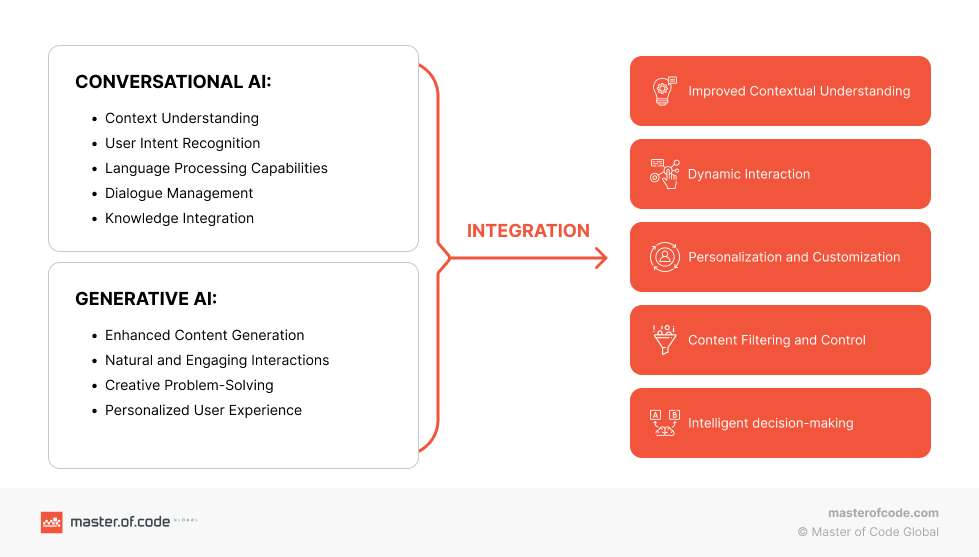
Moreover, the integration facilitates intelligent decision-making and dynamic interaction customization. It filters and controls content to align with client needs and preferences for more meaningful engagement. The synergy between Conversational and Generative AI is not just about processing information. It’s about creating connections and understanding that resonate with customers on an in-depth level.
In application, this means the tools can now navigate scenarios of greater complexity. They get better at interpreting and responding to varied inquiries. The solutions can route responses smartly, either handling them within the AI system or directing them to the appropriate human agent. Such versatility makes it an invaluable asset for businesses aiming to cover a wide range of interactions with enhanced efficiency and empathy.
Evolving Conversations: The Journey of Conversational AI
From FAQs, to transactional experiences
Conversational interface projects often start with a proof of concept involving launching a virtual assistant that can automate responses to frequently asked questions (FAQs) via chat or voice.
Organizations that want to increase customer satisfaction and achieve business goals need to start looking beyond just FAQs to reap the actual benefits of conversational AI.
Today’s advanced Conversational AI systems that utilize natural language understanding (NLU) can automate many complex transactions to make life easier for customers and internal teams. For example, banks could enable bill payments via virtual assistants instead of just navigating customers to a ‘how to pay’ webpage. A food retailer could allow customers to order food using a virtual agent rather than just navigating to a ‘menu’ page on their website. Check out more Use Cases of Conversational AI in the Finance industry to increase customer satisfaction and automate your processes.
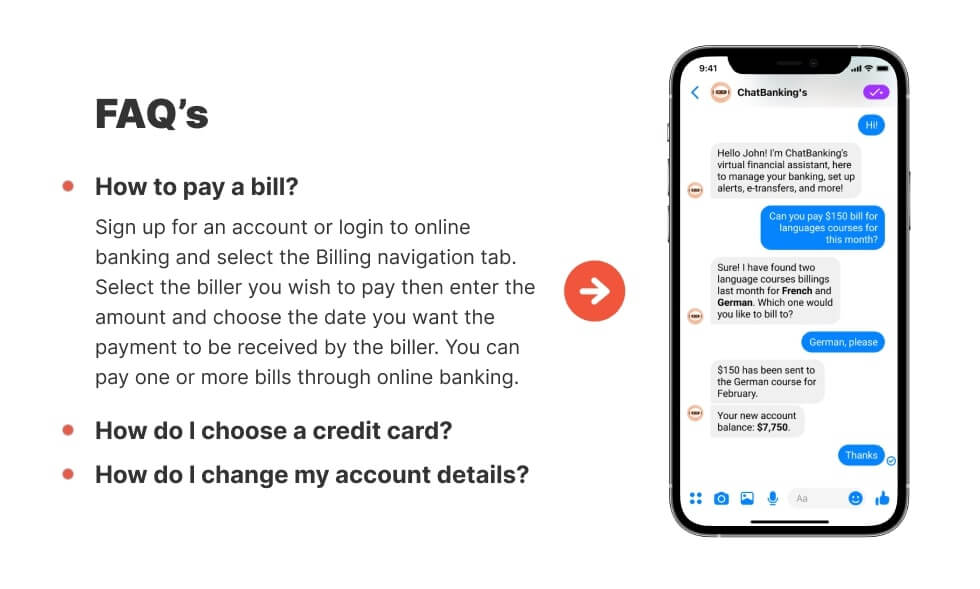
Building a transactional virtual assistant does not necessarily mean total call center automation with all possible transactions. Organizations need to take a structured approach and use data to prioritize key transactions that are high-volume and high-impact. This will help them deliver more value to their customers and move them closer to meeting their business objectives.
From linear, to flexible and cyclic conversations
Organizations need to be mindful that they are creating experiences for real people who are on the other end of the virtual assistants. Therefore it is paramount to keep customers in mind during the entire process. This shift is profound and places the onus on organizations to deliver a seamless user experience to lessen the user’s cognitive burden.
To continue providing a fluid customer experience, organizations need to anticipate and map out every possible scenario, query, and customer response. They need to design flexible conversations so that customers can converse using their own words in addition to picking from pre-defined menus. They should also be able to change the direction of dialogue or request additional information along the conversation’s path. Lastly, the Conversation Design needs to be cyclical so customers can pivot and circle back to the conversation as per their preference without starting over. Human to human conversations themselves are not linear and neither should conversational interfaces.
From release and forget, to iterating and tuning
Many organizations that build virtual assistants invest in upfront research and design to understand the customer journey and context. They sometimes, however, drop the ball on iterating and fine-tuning the experience after releasing the virtual assistants to actual customers.
It is crucial for organizations to monitor and evaluate actual conversations to really understand what is working and what isn’t. Reviewing user sessions to investigate errors and determine how to improve the experience should be an integral part of an ongoing sustainment plan.
Continuous iteration or ‘bot tuning’ is another critical practice for maintaining a balance of necessary intents and their training data. Tuning could involve various activities like adding, removing, or modifying utterances. Removing intents that don’t add value is just as important as creating new ones.
This results in customer experiences that are as seamless and as simple to navigate as possible. It also increases customer engagement and containment within the conversational experience.
From pre-defined answers, to Natural Language Understanding and Conversation Design
At its core, conversation design aims to mimic human conversations to make digital systems like virtual assistants easy and intuitive to use. The challenge is to make interactions with these systems feel less robotic by understanding the context and purpose of the customer in order to direct them to relevant solutions.

Many organizations, however, still employ hard-coded or rule-based pattern matching with small rule-sets for their conversational interfaces. This results in higher abandonment rates, low engagement, and perceived project failures.
Natural Language Understanding (NLU) technologies utilize machine learning and training data that allows them to understand user utterances without the need to manually hard code all the pattern matching logic. NLU platforms also provide hooks into domain-specific knowledge bases and forums.
By integrating and maximizing the power of NLU platforms, organizations can enable virtual assistants to respond to human queries efficiently and effectively, improving customer engagement and providing an overall positive customer service experience.
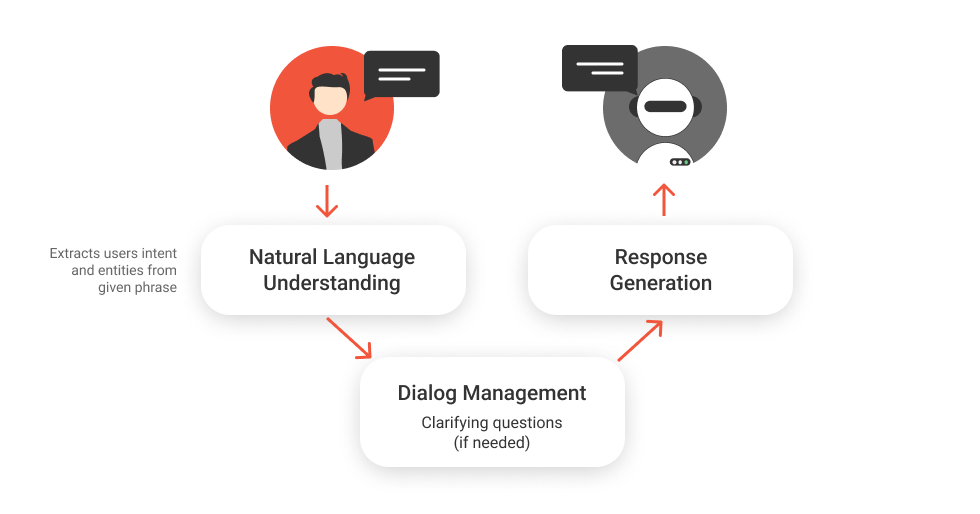
From disjointed multiple bots, to a seamlessly integrated omnichannel experience
With an increase in the development of virtual agents, some larger organizations are facing a new challenge. Individual departments are creating conversational interfaces with a narrow scope of handling queries related to very specific use-cases or business functions such as HR or IT. As a result, accessing and discoverability of the numerous virtual assistants becomes a challenge for users.
When appropriate for their situation, organizations can overcome this challenge with the introduction of a “master virtual assistant”. This assistant can be made responsible for handling a range of tasks for the customer by understanding their intent and routing the request to the use-case-specific virtual agent. For example, a financial institution may have separate chatbots to handle commercial and consumer mortgage use cases and a master chatbot that seamlessly manages the interactions across them.
Read more about which processes that could be automated for HR with help of AI.
Key Takeaways
As we have explored, Conversational AI is redefining client care and retention. The technology not only addresses the current challenges in CX but also opens up new avenues for enhanced consumer interaction and business growth. From providing personalized offers to boosting service quality, artificial intelligence is an indispensable tool for any forward-thinking enterprise.
At Master of Code Global, our leadership in Conversational AI services positions us to help your company stay ahead of the curve. With our guidance, adopting discussed trends becomes a seamless process, leading to improved business outcomes. We provide an omnichannel approach, ensuring consistent CX across all platforms.
Partner with us for a full-cycle artificial intelligence strategy and robust integration capabilities. We prioritize flexible communication and stringent data security in all our applications. Contact Master of Code Global to elevate your user engagement with advanced AI solutions. Let’s redefine your customer interactions together.

